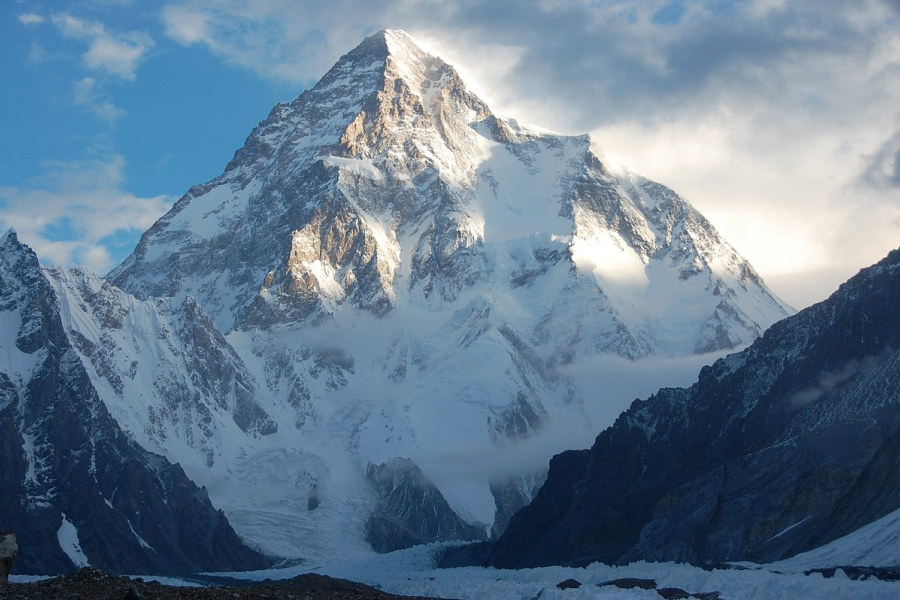Nestled in the Karakoram Range, K2, the second-highest mountain on Earth, stands as a testament to nature’s grandeur and challenges climbers with its awe-inspiring beauty and treacherous conditions. Unveil the secrets of K2 Mountain during your journey with the focus on “K2 Mountain – Facts and Information”. For those seeking the ultimate adventure, explore the captivating landscapes and rich history of the K2 Base Camp trek. This expedition promises an unforgettable experience.
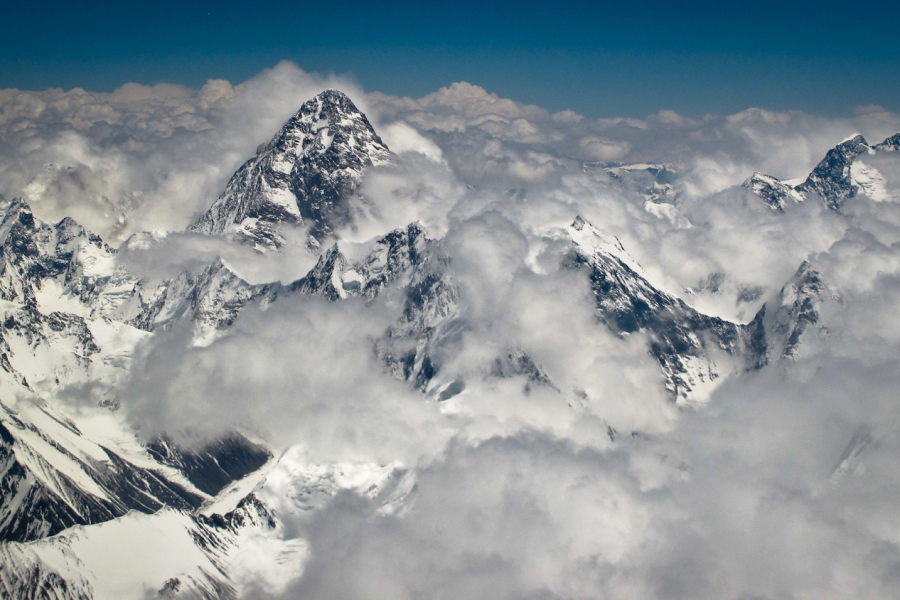
FAQS:
Is K2 in Pakistan or China?
K2 is situated on the border between China and Pakistan, with a significant portion of its base in Pakistan’s Gilgit-Baltistan region and a minor part in China’s Xinjiang Autonomous Region. The mountain straddles the edge, and the standard route for climbers usually approaches from the Pakistani side. The precise location of the border in the high-altitude region adds an international dimension to K2’s prominence.
Is K2 harder than Everest?
Many experienced mountaineers consider K2 more challenging and technically complex than Everest. While Everest is the world’s highest peak, standing at 29,032 feet (8,848 meters) above sea level, K2’s ascent involves steeper and more technically demanding sections. The weather conditions on K2 are also notoriously harsh, with high winds and sudden storms, making the climb more difficult. K2 has a higher fatality rate among climbers, contributing to its reputation as one of the most challenging peaks to conquer.
What is K2 Mountain’s real name?
K2 is commonly known as K2, and this name is derived from its designation in the Karakoram mountain range. The term “K2” means the second-highest peak in the Karakoram. British explorers initially surveyed the mountain in the early 20th century, and the notation K2 was used as part of their mapping and naming system. Unlike Mount Everest, which has a local name (Sagarmatha in Nepal and Chomolungma in Tibet), K2 is widely recognized by its alphanumeric designation.
What does the “K2” stand for?
The “K” in K2 stands for Karakoram, the name of the mountain range in which K2 is situated. The “2” signifies that K2 is the second-highest peak in the Karakoram Range. The designation K2 was assigned during the Great Trigonometric Survey of India, a series of mapping and surveying efforts conducted by British explorers in the 19th century. This naming convention, using a letter and number, was a systematic way to identify and distinguish various peaks in the region.
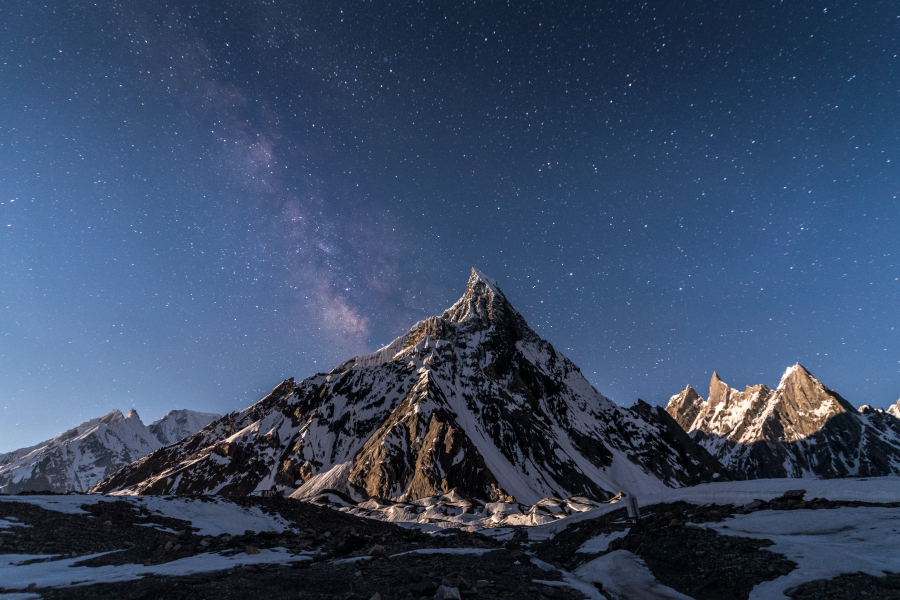
K2 Location:
In the Baltoro Karakoram region, K2’s coordinates are approximately 35.8815° N latitude and 76.5132° E longitude. This formidable peak is part of the more extensive Himalayan range, drawing adventurers from around the globe. Read more about the K2 Base Camp Trek Pakistan.
Height:
The crown jewel of the Karakoram Range, K2 proudly reaches an altitude of 28,251 feet (8,611 meters) above sea level. Second only to Mount Everest, K2’s towering summit, presents an unparalleled challenge to climbers, attracting those seeking the ultimate test of skill and determination.
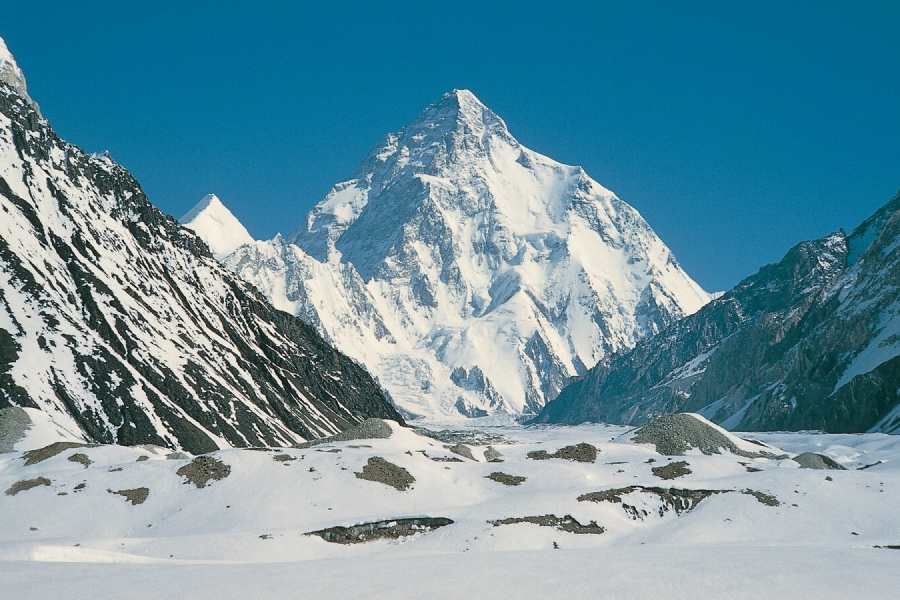
Interesting Facts about K2:
As we explore K2’s unique characteristics, one cannot ignore the intriguing facts that add to its mystique. K2 is notorious for its unpredictable weather, with winds that can reach hurricane force. Its remote location also contributes to the difficulty of reaching its summit, making successful ascents even more remarkable.
The Challenging Ascent:
The rise of K2 Expedition is an undertaking that demands not only physical strength but also mental fortitude. Climbers face technical challenges, including steep rock and ice sections. They must navigate the notorious Bottleneck—a narrow and hazardous passage. The risks associated with K2 have earned it a reputation as one of the deadliest peaks in the world.
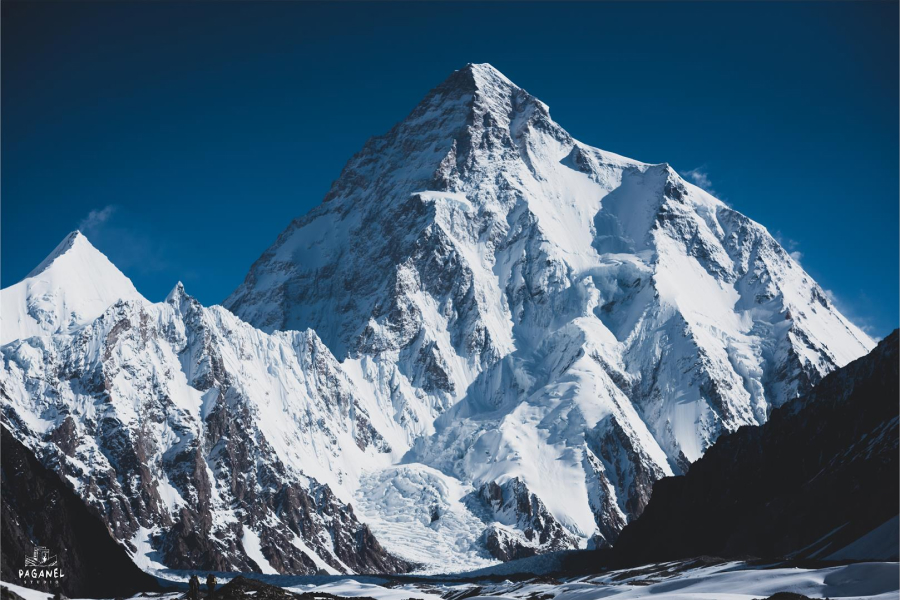
Historical Significance:
Beyond its imposing stature and challenging terrain, K2 boasts a rich history. British surveyors first surveyed the mountain in the early 20th century, and its name reflects its place in the Karakoram Range. The “K” stands for Karakoram, and the “2” denotes the second peak measured in the region. This history adds a layer of intrigue to the mountain, as each successful ascent becomes a part of mountaineering lore.
Flora and Fauna:
While K2’s icy facade may seem lonely, the surrounding region teems with life. Alpine and subalpine ecosystems support a variety of flora and fauna, including hardy grasses, mosses, and elusive snow leopards. Exploring K2’s ecosystem provides a unique perspective on the delicate balance between nature’s beauty and harsh challenges.
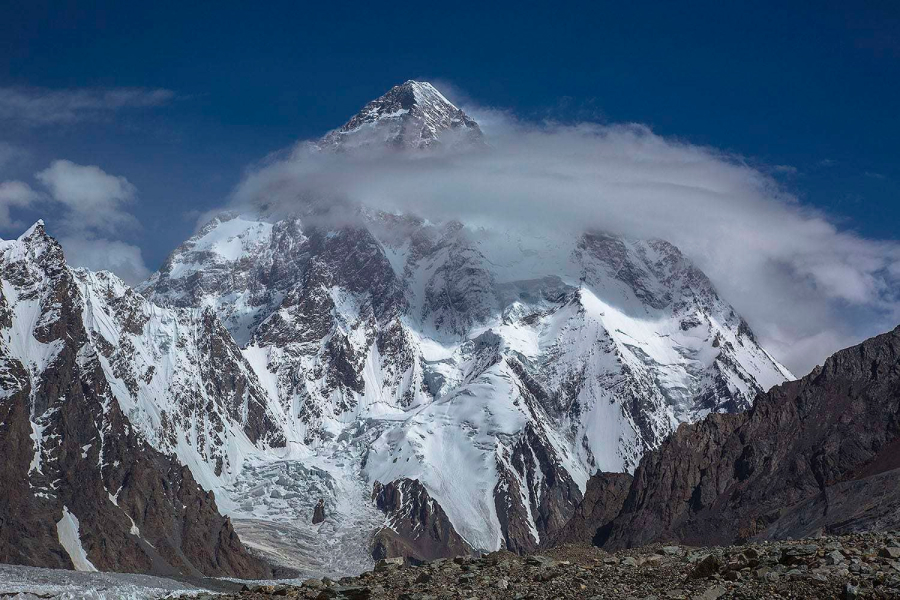
K2 in Popular Culture:
K2’s allure extends beyond the mountaineering community, influencing popular culture. Books, documentaries, and films have captured the drama and danger of scaling this imposing peak. Notable expeditions, triumphs, and tragedies have been immortalized in various mediums, further solidifying K2’s place in the collective imagination.
Conservation Efforts:
With the increasing interest in mountaineering, there’s a growing awareness of the need to preserve these natural wonders. Conservation efforts around K2 focus on maintaining the delicate ecosystem, managing waste, and promoting responsible climbing practices to ensure that future generations can appreciate the mountain’s grandeur.
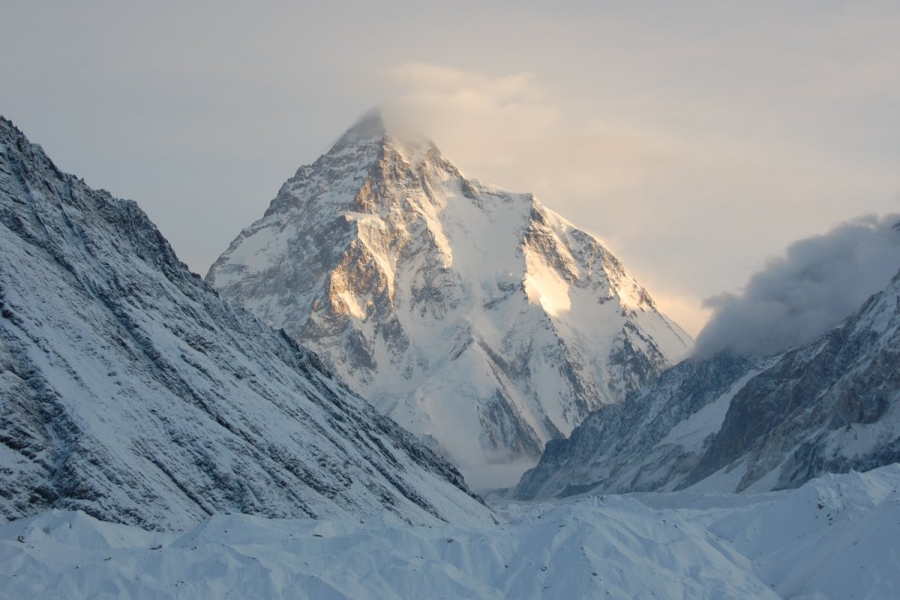
K2’s Influence on Climbing Culture:
K2’s formidable reputation has shaped the culture of mountaineering. The challenges posed by this peak have become a benchmark for climbers worldwide. Many aspiring mountaineers dream of conquering K2, viewing it as the ultimate test of their skills and endurance. Its influence extends beyond the physical realm, symbolizing the pursuit of excellence and the willingness to face seemingly insurmountable obstacles.
Notable Climbing Expeditions:
K2 has witnessed numerous expeditions over the years, each with its own tale of triumph or tragedy. The first successful ascent was achieved by an Italian team in 1954, marking a historic moment in mountaineering. Subsequent expeditions have added layers to K2’s story, showcasing the indomitable human spirit, with climbers facing and overcoming extreme conditions.
K2 and Everest: A Comparative Glimpse:
While Everest often takes the spotlight as the world’s highest peak, K2 offers different challenges. Comparing the two provides insight into the diverse nature of mountain climbing. K2’s technical difficulties and unpredictable weather differentiate it from Everest, emphasizing the unique characteristics that draw climbers to each respective summit.
The Future of K2 Exploration:
As technology and mountaineering practices advance, K2 exploration holds exciting possibilities. Ongoing research, improved gear, and evolving climbing techniques may contribute to a deeper understanding of the mountain and enhance safety measures for those daring enough to attempt the ascent. The evolving landscape of mountaineering ensures that K2 will continue to be a focal point of exploration. Read more about the K2 Base Camp Trek | Pakistan’s No.1 K2 Guide.
The Ethical Dimensions of K2 Climbing:
In recent years, discussions about the ethical considerations of climbing K2 have gained prominence. The impact on the environment, the risks involved, and the responsibilities of climbers have become crucial topics. Many advocates argue for sustainable and responsible climbing practices to preserve the mountain’s pristine environment and ensure the safety of both climbers and the local community. Read more about the K2 base camp trek – Weather and Seasonality.
A Source of Inspiration:
Beyond the realm of mountaineering enthusiasts, K2 serves as a symbol of inspiration for individuals facing challenges in their lives. The mountain’s metaphorical significance extends to resilience, determination, and pursuing goals despite formidable obstacles. Stories of climbers overcoming adversity on K2 inspire many to tackle their metaphorical summits.
Climate and Weather Challenges:
K2, the second-highest mountain globally, presents climbers with extreme climate and weather challenges. The high elevation brings freezing temperatures, even in summer, and powerful, unpredictable winds that can reach hurricane force. Sudden storms with heavy snowfall and avalanche risks add to the difficulty. Positioned near the jet stream, K2 experiences severe weather changes. With limited climbing windows and challenges like reduced oxygen levels, successful ascents require meticulous planning, adaptability, and a thorough understanding of the mountain’s ever-changing meteorological conditions.
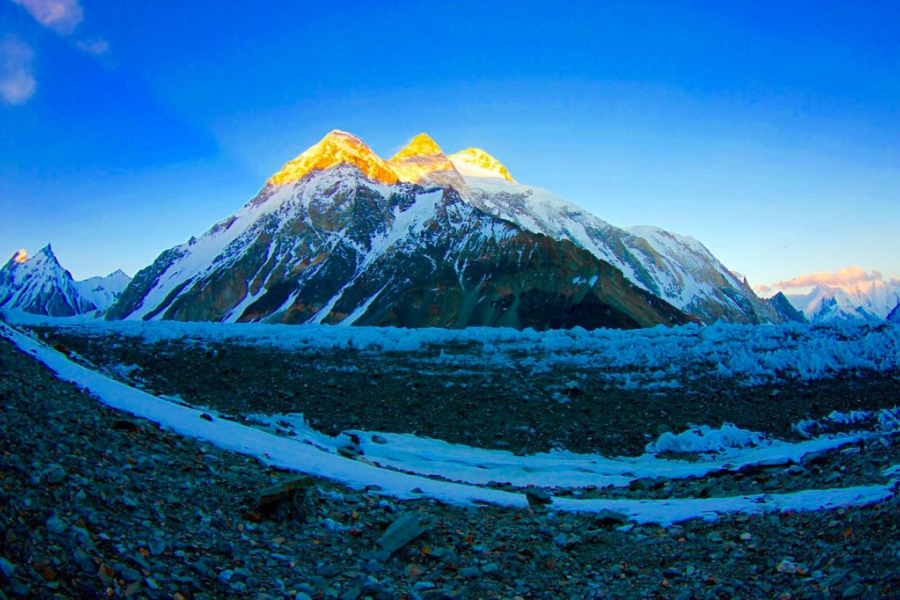
Cultural Significance:
K2 holds profound cultural significance for the local communities in Pakistan and China. It is a sacred and majestic peak often woven into local myths and traditions. The mountain symbolizes resilience and spiritual importance, shaping the cultural fabric of the regions surrounding its base. K2’s allure is not solely confined to mountaineering. Still, it extends to a deeper connection with the cultural identity of those living in its shadow.
Notable Climbing Records:
K2 has been witness to numerous remarkable climbing feats, each etching its own narrative in mountaineering history. Notable records include the fastest ascent, youngest climber to reach the summit, and other impressive achievements. These records reflect the extraordinary skills and determination of climbers who have sought to conquer the challenges posed by K2, adding layers to the mountain’s legacy as a pinnacle of human achievement.
Geological Formation:
Understanding K2’s geological formation adds depth to its mystique. Situated in the Karakoram Range, the mountain’s origin is rooted in complex geological processes that shaped the surrounding landscape. The collision of tectonic plates and subsequent uplift led to the creation of this formidable peak. Exploring the geological history of K2 provides a scientific perspective, complementing the awe-inspiring natural beauty that captivates climbers and enthusiasts alike.
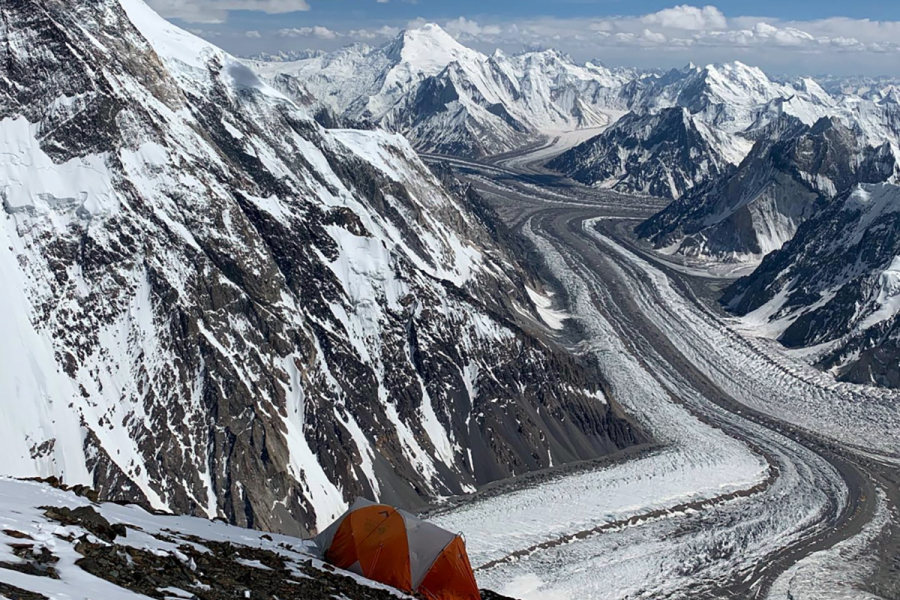
Impact on Local Economy:
K2’s towering presence has a tangible impact on the local economy, particularly in the communities surrounding its base. Mountaineering tourism contributes significantly to livelihoods, providing opportunities for locals as guides, porters, and in hospitality services. However, the balance between economic benefits and environmental preservation is delicate, necessitating sustainable practices to ensure the long-term well-being of both the mountain and its neighboring communities.
Notable K2 Tragedies:
While K2 is a beacon of triumph for successful climbers, it has also witnessed tragic events that have left a lasting impact on the mountaineering community. Notable tragedies, including accidents and loss of life, serve as poignant reminders of the inherent risks associated with scaling such formidable peaks. These incidents underscore the importance of caution, preparedness, and respect for the unpredictable nature of high-altitude climbs.
K2 Base Camp:
The journey to K2’s summit often begins at the K2 Base Camp, a pivotal staging point for climbers. Nestled amidst breathtaking scenery, the base camp serves as a hub for acclimatization, preparation, and reflection. Climbers gather here before embarking on the challenging ascent, experiencing the camaraderie of shared aspirations and the anticipation of what lies ahead. The K2 Base Camp, surrounded by the grandeur of the Karakoram Range, is an essential chapter in the narrative of conquering this majestic peak.
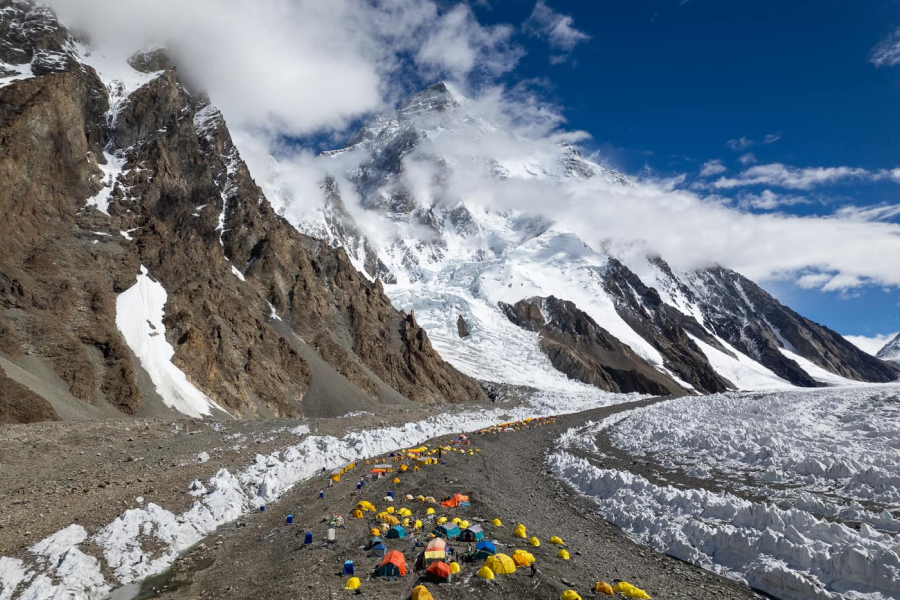
Environmental Conservation Initiatives:
Recognizing the environmental impact of K2 mountaineering, initiatives are underway to promote responsible practices. These include waste management programs, reforestation projects, and educational campaigns aimed at fostering sustainable climbing. Collaboration with local communities emphasizes a collective commitment to preserving K2’s pristine environment, striking a balance between the thrill of ascent and the imperative of ecological conservation.
Tips for Prospective Climbers:
For those considering the ascent of K2, thorough preparation, and respect for the mountain are paramount. Physical fitness, technical skills, and a deep understanding of the challenges posed by K2 are prerequisites. Collaborating with experienced guides and adopting environmentally conscious practices contribute to a safer and more responsible climbing experience.
Conclusion:
K2 is a majestic and challenging testament to the allure of the world’s highest peaks. Its breathtaking beauty, rich history, and formidable challenges make it a focal point for adventurers and a source of inspiration for many. As technology and climbing practices evolve, K2’s mystique will continue to captivate the human spirit, reminding us of the indomitable will to explore the heights of our planet. Read more about the K2 Expedition | Pakistan’s No.1 Guides.

